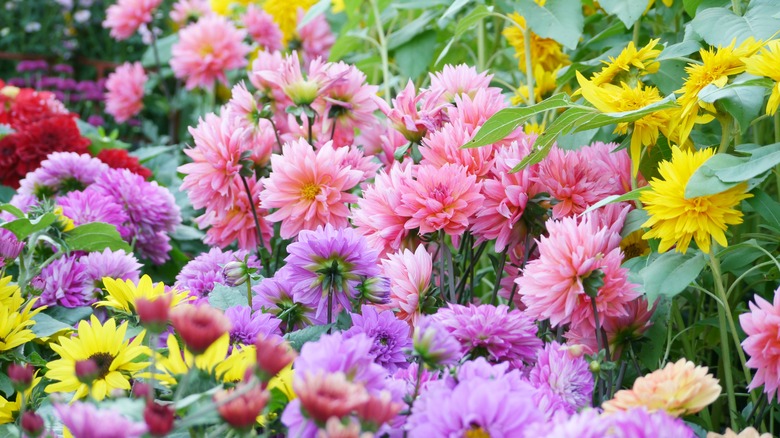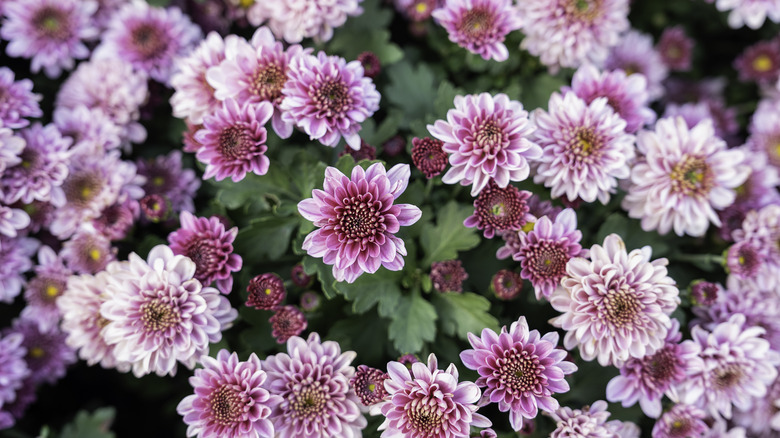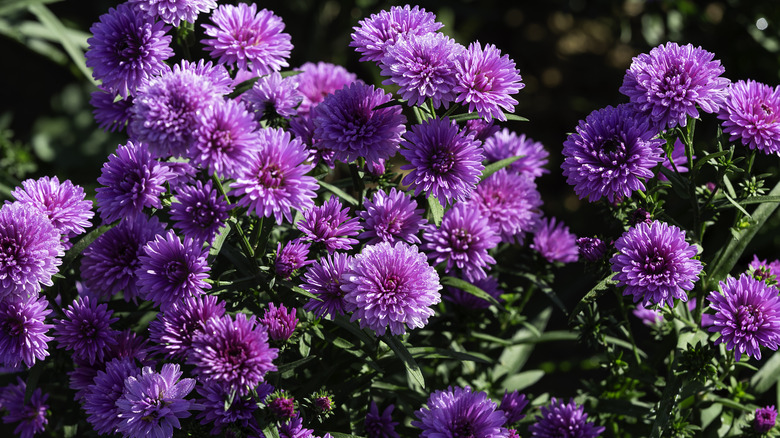This Gorgeous Flower Doubles As Natural Pest Control In Your Garden
Chrysanthemums, often admired for their vibrant blooms and diverse colors, serve a dual purpose in the garden that extends beyond their ornamental value. While these flowers are primarily planted for their beauty, they also play a significant role in natural pest control, an aspect that many gardeners may overlook. The key to chrysanthemums' pest-repelling properties lies in the natural insecticide they produce, called pyrethrin. This compound is highly effective at deterring a wide range of insects, making chrysanthemums not just a visual asset but a functional one as well. It even repels cockroaches.
Pyrethrin, derived from the flower heads of chrysanthemums, targets the nervous systems of insects, leading to paralysis and death. This natural insecticide is particularly effective against common garden pests such as aphids, spider mites, ticks, and even mosquitoes. Unlike many chemical insecticides, pyrethrin is biodegradable and poses minimal risk to humans and pets when used properly. It is also less likely to harm beneficial insects like bees, making it a more environmentally friendly option for pest management.
Chrysanthemums are especially valuable in gardens where pest populations need to be managed without the use of synthetic chemicals. By strategically placing these plants around your garden, you can create a natural barrier against pests. The strong scent of chrysanthemums, combined with the pyrethrin they produce, helps to repel insects before they even have a chance to reach more vulnerable plants.
Strategic integration of chrysanthemums enhances their pest control benefits
These flowers can be particularly effective when used as companion plants, where their insect-repelling properties protect neighboring plants that are more susceptible to pest attacks. For example, placing chrysanthemums near vegetable gardens or around the perimeter of your garden beds can help deter insects that might otherwise feast on your crops. They work well near tomatoes but keep them clear of lettuce.
Chrysanthemums are also effective when used as border plants along walkways or garden edges, creating a natural insect-repelling barrier. This placement not only helps protect the garden's interior but also adds a layer of defense around areas where pests are likely to enter. Additionally, chrysanthemums can be planted in containers and strategically placed near windows, doors, or patios, helping to keep mosquitoes and other flying insects away from outdoor living spaces.
The type of chrysanthemum you choose can influence its effectiveness as a pest deterrent. Some varieties are particularly rich in pyrethrin, such as Chrysanthemum cinerariifolium, which is commonly used in the production of commercial pyrethrin-based insecticides. By selecting these more potent varieties, you can enhance the natural pest control capabilities of your garden. Additionally, maintaining the health and vigor of your chrysanthemums through regular care, such as proper watering and pruning, will ensure they remain effective as both ornamental plants and pest deterrents throughout the growing season.
How to care for chrysanthemums to maximize their pest control benefits
To fully harness the pest control benefits of chrysanthemums, it's crucial to ensure these plants are healthy and thriving. Proper care not only enhances their visual appeal but also increases their effectiveness as a natural insect repellent. Chrysanthemums are relatively low maintenance, but they do require specific conditions to flourish. Ensuring that these conditions are met will allow the plants to produce the maximum amount of pyrethrin, thereby optimizing their pest control capabilities.
Chrysanthemums need plenty of sunlight. They thrive in full sun, requiring at least six hours of direct sunlight per day. Insufficient light can weaken the plants, reducing their ability to produce the insect-repelling compounds that make them so valuable. Additionally, chrysanthemums prefer well-drained soil with a slightly acidic to neutral pH. Poor drainage can lead to root rot and other diseases, which can compromise the plant's health and its ability to fend off pests. Keep your garden clear of grub worms, as these pests can damage the shallow roots of the chrysanthemum plant.
Watering is another critical aspect of chrysanthemum care. While these plants need regular watering, especially during dry spells, it's important to avoid overwatering, which can lead to fungal infections. Water the base of the plants to keep the foliage dry and reduce the risk of diseases. Regular deadheading, or removing spent flowers, encourages more blooms and extends the flowering season, which in turn prolongs the period during which the plant can repel pests.


